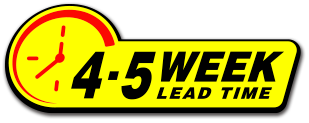
SPECIFICATIONS AND IMPORTANT DESIGN CRITERIA:
WHAT YOU NEED TO MAKE YOUR DOOR AND BUILDING A PERFECT FIT

The bifold hangar doors can be designed to the same loading requirements for live loads, dead loads and wind loads on the hangar building, to resist all anticipated loads without sagging, bowing or conflicting with its smooth and efficient operation. Your door design can be approved and sealed by a professional engineer registered in the state where the project is located for the proper wind loading and exposure.

The Customer, Contractor, Owner, or Building Manufacturer:
When your bifold door is in the full open position, the bifold door tends to pull away
from the building at the hinge line, exerting considerable horizontal loads on the building
structure in the open position. Your building header design must meet standard deflection and
strength criteria, both in vertical and horizontal directions to support the bifold door in all positions.

- The building header shall be designed to accommodate horizontal and vertical building deflections to support the bifold door in all positions (with the proper lateral bracing).
- The buildings door columns must be framed of the proper design and size to reinforce the opening (with lateral bracing) and to carry all loads and vibrations imposed thereon.
- Schweiss provides the A-1, A-2, A-3, and A-4 spec sheets: Read through and understand them and have your building designed for our door. The bifold should have solid footing / sill directly underneath the doorframe and extending beyond the doorframe outward from the door to provide a base for the door's base weather seal to prevent the flow of water (into or under) the door installation.
- The finished floor / asphalt of the building should be designed to prevent flow of water (into or under) the door installation. Sills shall have a slight slope outward of the bifold door to prevent the flow of water under the door installation.

- Wind loaded doors: To meet standard local codes.
- Extra heavy wind loading requirements available.
- Wind Pins: Furnished on doorframes to increase the wind load strength and provide a sturdy installation.
- Wall Pins: Are incorporated into the doorframe to provide additional wind load when needed.

Customer / Electrician Must Provide:
- Proper voltage and electrical service to the door's power unit.
- Proper wire from the service panel to the up/down/stop switch on our door.
- Install any electrical conduit.
- Electrical components placed on the door must meet the requirements.












